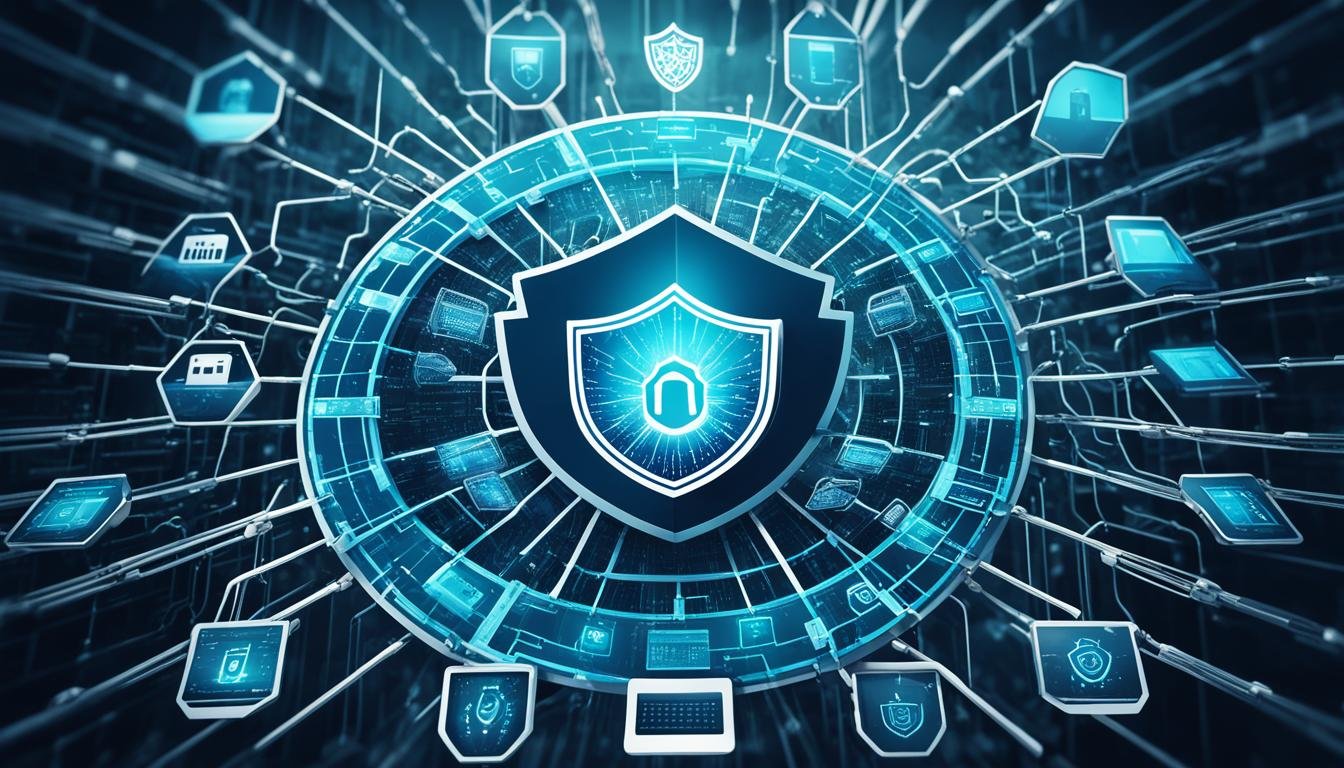Cybersecurity Best Practices: How to secure networks and data against emerging threats.
Cybersecurity is a big worry in our tech-filled world. We use digital tools more and keep lots of private info online. This means cyber threats are bigger and more dangerous than ever. In fact, cybercrime could cause $10.5 trillion in damage by 2025.
With cyber threats getting smarter, it’s key for people, companies, and governments to use the best cybersecurity steps. We’ll look at the main ways to keep your digital stuff safe and fight off new threats.
Key Takeaways:
- Implement strong network security measures to protect against unauthorized access.
- Establish robust data protection protocols, including encryption and access controls.
- Create an incident response plan to handle cyber threats effectively.
- Regularly update and patch vulnerabilities to minimize the risk of exploitation.
- Educate employees through security awareness training programs.
Network Security: Safeguarding your digital infrastructure from cyber threats.
Network security is key to protecting organizations from cyber threats. It’s vital for keeping digital infrastructure and sensitive data safe from unauthorized access and breaches.
Setting up strong access controls is a basic step in network security. By using strict user authentication and permissions, only authorized people can get into networks. This reduces the risk of unauthorized access and cyber attacks.
Encryption is also crucial for network security. It encrypts data while it’s being sent, stopping unauthorized people from getting it. This makes data unreadable to hackers, keeping it safe.
To fight cyber threats, focusing on vulnerability management is important. Regular checks for weaknesses help organizations stay ahead of hackers. This ensures security measures are strong enough.
Try different network penetration testing strategies that can indicate where security gaps exist before attackers exploit them. By simulating real-world cyber threats, businesses can proactively strengthen their defenses and protect sensitive data.
The risks of not focusing on network security are big. Companies could lose money, harm their reputation, and lose customer trust. It’s important for businesses to invest in strong network security to fight cyber threats.
Using strong access controls, encryption, and managing vulnerabilities helps create a secure network. These steps make it harder for cyber threats to succeed. They greatly lower the chance of data breaches and other cyber issues.
Data Protection: Safely guarding sensitive information from unauthorized access.
Data protection is key in cybersecurity. It ensures sensitive info like customer data and financial records stays safe. It’s vital for organizations to protect against data breaches and unauthorized access.
Access controls are crucial for data protection. They help limit who can see or change sensitive data. This includes setting up user accounts, giving access based on job roles, and checking access rights often. These steps stop unauthorized people from getting to confidential data.
Encryption is also vital for data protection. It turns data into a code that only authorized people can read. This way, even if data is stolen, it can’t be used. Encryption is used for data moving over networks and data stored in databases or on devices.
Security awareness training is also important. It teaches employees how to spot and deal with security threats. They learn how to handle sensitive data safely and spot phishing scams. This training helps employees play a big part in keeping data safe.
Importance of Data Protection
Good data protection is key to keeping sensitive info safe. It keeps data confidential, whole, and easily accessible. With strong access controls, encryption, and training, organizations can lower the risk of data breaches and cyber-attacks.
Putting data protection first shows an organization cares about its customers and partners. It helps avoid data breaches, legal problems, and damage to reputation. It also meets laws like the GDPR and CCPA.
- Implement access controls to limit unauthorized data access.
- Utilize encryption techniques to secure data in transit and at rest.
- Invest in security awareness training to educate employees and enhance their understanding of data protection best practices.
A strong data protection plan is the base of good cybersecurity. It helps keep important information safe.
Incident Response: Developing a proactive plan to mitigate cyber threats.
Incident response is key in cybersecurity. It means making a plan to spot, handle, and bounce back from cyber threats. Companies need teams ready to act fast and fix security issues.
It’s important to have clear steps for responding to incidents. This means knowing what to do when something goes wrong, like cutting off affected systems and figuring out the damage. Having these steps ready helps keep cyber incidents under control and reduces harm.
Practicing with drills is vital for incident response teams. These drills mimic real situations to check how well the team works together, makes fast decisions, and follows the plan. This helps find and fix any weak spots in handling cyber threats.
“Having a well-prepared incident response plan can make all the difference in minimizing the impact of a cyberattack. By combining technical expertise with well-defined response procedures, organizations can effectively detect and neutralize threats before they escalate.”
It’s also key to train employees on security. Teaching them about cyber threats and risks makes the whole company safer. Employees often spot suspicious things first, like phishing emails. Training them helps build a strong defense against cyber threats.
Effective incident response plans should include the following:
- Defined roles and responsibilities for incident response team members.
- Clear and documented response procedures.
- Regular training and drills to test the efficiency of the response plan.
- Prioritized communication channels to ensure effective collaboration.
- Post-incident analysis and improvements based on lessons learned.
Putting incident response and security training first helps protect against cyber threats. This way, companies can lessen the blow of security issues.
Conclusion
Implementing cybersecurity best practices is key for keeping networks and data safe. Using tools like firewalls and intrusion detection systems helps spot and fix risks. Regular checks for vulnerabilities are also important.
Strong data protection steps, like encryption and training employees, keep sensitive info safe. It’s also vital to have a solid incident response plan ready. This way, you can quickly handle cyber threats and lessen their effects.
With more data in the cloud, cloud security is a big deal. Using top-notch security tools, like multi-factor authentication, keeps cloud data safe. This helps protect against unauthorized access and data breaches.
By sticking to these best practices and keeping up with new cybersecurity trends, both people and companies can stay one step ahead of cyber threats. The fast-changing world of cybersecurity means we must always learn more, be proactive, and check our security often. This helps us stay strong against new dangers.







